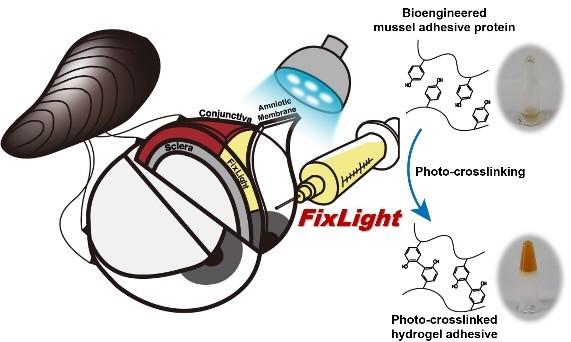The eye is the first sensory organ that recognizes the presence or shape of an object. The conjunctiva is a thin mucous membrane that covers the front half of the eyeball. It protects the eye by secreting mucus and tears for lubrication, and prevents microorganisms from entering. However, since it is exposed to the air, it is susceptible to damages by microorganisms, bacteria, or dust. In fact, if fibrovascular tissues are left to propagate on its surface, they can lead to diseases like pterygium, which can cause visual deterioration. To treat such conditions, an operation to remove and regenerate the damaged conjunctiva is performed. Recently, a Korean research team has developed a new method for performing sutureless amniotic membrane transplantation using the mussel adhesive protein.
Professor Hyung Joon Cha’s research team at POSTECH (Ph.D. candidate Seong-Woo Maeng, Dr. Tae Yoon Park) with the team led by Professor Woo Chan Park of the Department of Ophthalmology at Dong-A University College of Medicine (Dr. Ji Sang Min, currently at Kim’s Eye Hospital of the Konyang University School of Medicine) have together applied a light-curable protein bioadhesive named FixLight to an animal model that simulated the transplantation of the amniotic membrane on an actual ocular surface. As a result, it was confirmed that the operation could be completed more than five times faster than the traditional suture method and the therapeutic effect of the conjunctival regeneration through stably bonded amniotic membranes could successfully replace the conventional procedure.
The amniotic membrane is the innermost membrane of the placenta that surrounds and protects the embryo. Since it contains many factors that promote epithelial regeneration, performing amniotic transplantation to reconstruct the ocular surface has been widely practiced. However, the current method stitches the membrane with sutures and fixes it to the surface of the eyeball, which leaves a scar. And since precise sutures are required due to the thinness of the amniotic membrane, the operation is considerably time-consuming.
To this, the POSTECH research team has developed a light-curable adhesive that exists in a liquid state when unexposed to light, but changes into a hydrogel within a few seconds when exposed to visible light of a specific wavelength. Going a step further this time, in joint effort with researchers from Dong-A University College of Medicine, the amniotic membrane was transplanted without sutures on the ocular surface of a rabbit model with conjunctiva defects using a light-curable bioadhesive.
The joint research team used a visible light-curable bioadhesive with liquid-solid photocrosslinking characteristics in the amniotic membrane transplantation surgery, focusing on the high transparency of the amniotic membrane. After evenly coating the liquid adhesive, the amniotic membrane was adhered to the defect site by crosslinking it with light of a specific wavelength. In an experiment using a rabbit conjunctiva defect model, the researchers observed stable tissue adhesion ability that showed no significant difference from suture-treated cases even on the wet surface of the eye. In addition, after epithelialization progressed over the transplanted amniotic membrane, the adhesive completely biodegraded and regenerated into an integrated epithelial tissue.
Professor Hyung Joon Cha of POSTECH explained, “We confirmed the effectiveness of a new amniotic membrane transplantation method for conjunctival reconstruction in an actual animal model using the mussel adhesive protein, an original biomaterial.” He added, “It is anticipated to be highly useful as a safe bioadhesive to replace sutures in various medical fields.”
FixLight – the visible light-curable protein bioadhesive – shows promise for commercialization in the near future as it has completed the technology transfer to Nature Gluetech Co., Ltd. and is awaiting clinical trials as a safe bioadhesive that can fully replace surgical sutures.
“The amniotic membrane transplantation is an important operation in ocular surface reconstruction and this visible light-curable bioadhesive enabled facile and rapid operation,” remarked Professor Woo Chan Park of Dong-A University College of Medicine. “This technique shows promise to be applicable to other ophthalmological surgeries such as closing of incisions after cataract operation or other transplantations of the ocular surface, such as conjunctival autografting.”
###
The findings from this research were published online in Advanced Healthcare Materials, an international journal on biomaterials. The study was carried out as part the Korea Health Technology R&D Project through the Korea Health Industry Development Institute funded by the Ministry of Health and Welfare, the Nano-New Materials Core Technology Development Program funded by the Ministry of Science and ICT, and the Marine Biotechnology Program of the Korea Institute of Marine Science & Technology Promotion funded by the Ministry of Oceans and Fisheries of Korea.
Media Contact
Jinyoung Huh
[email protected]
Related Journal Article
http://dx.





